The 10 Best Corded & Cordless Reciprocating Saws for the Money
Make Quick Work of Any Cutting Job with the Best Corded and Cordless Reciprocating Saws Available Today
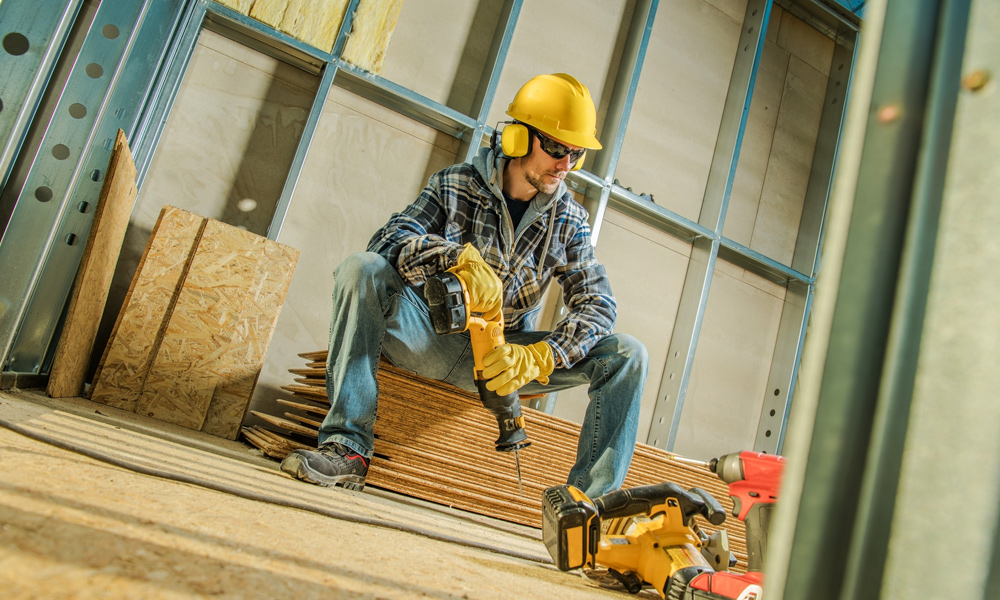
With so many varieties on the market and so many variables to consider, it’s been tough to narrow down the best reciprocating saw, but someone had to do it. Reciprocating saws, also called recip saws, recipro saws, or even saws-all, are powerful and versatile handheld saws that can cut through wood, metal, masonry, fiberglass, and more. Reciprocating means that the cutting action is achieved through alternating pushing and pulling the blade.
There are many varieties of blades for these saws, each designed for a specific task. The most common blades are made from carbon steel, but there are also high-speed steel, bi-metal steel, carbide-tipped, carbide grit, and diamond blades. When in doubt, it’s best to use combination blades for general DIY use and specialty blades for larger jobs.
The landscape of reciprocating saws is changing with better technology and higher performance, so which one is best for you? Check out our list of the best corded and cordless reciprocating saws for any project.
View the Best Reciprocating Saw on the Market, Below.
- DEWALT Bare-Tool DC385B Cordless
- DEWALT DCS387P1 20v Kit
- BLACK+DECKER BDCR20B 20V
- SKIL 9216-01 9 Amp
- DEWALT DWE304 10-Amp
- Bosch RS428 14 Amp Reciprocating Saw
- PORTER CABLE PCC670B 20v
- Milwaukee 6519-31 12 Amp Sawzall
- Makita JR3050T 11 Amp
- Metabo HPT Reciprocating Saw
1. DEWALT Bare-Tool DC385B Cordless
Best Cordless Reciprocating Saw to Tackle Any Task

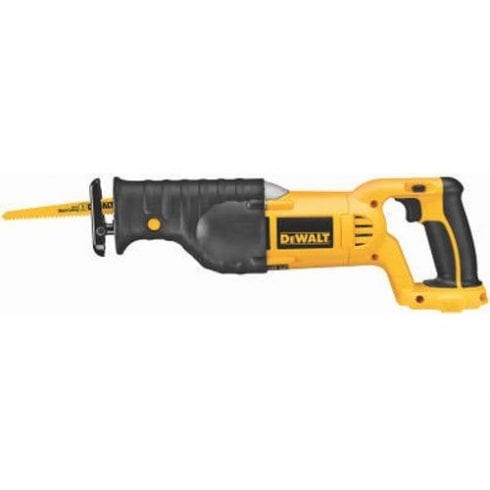
This cordless, 18-volt reciprocating saw is ready to cut through anything that gets into its path. For jobs that require building, remodeling, or tearing down, this saw works like a ninja. It features a high-performance, variable-speed motor that drives up to 3000 strokes per minute. It also holds its own with an aggressive stroke length of 1-1/8-inch.
The four-position blade clamp allows for greater versatility in limited clearance, making it possible to flush-cut from nearly any angle.
The lever-action clamp makes it quick and easy to change the blade, and the sure-grip, anti-slip rubber handles increase handling control and reduce fatigue. Always a trusted name in power equipment, DeWalt backs this cordless reciprocating saw with a three-year limited warranty. This covers any faulty material or workmanship defects. Not to mention - there's also a one-year free service contract that covers replacement of all worn parts due to normal use.
This lightweight, portable cordless reciprocating saw handles well for any size job. It's versatile and convenient enough to use with metal, wood, plumbing, equipment repair, in tight crawlspaces, roofing, and more. Constructed well, this saw makes a durable and powerful substitution for other standard cordless reciprocating saws, with many different types of blades that can be used.
Check Price on Amazon ➞2. DEWALT DCS387P1 20v Kit
Best Cordless Reciprocating Saw for Low Light Situations
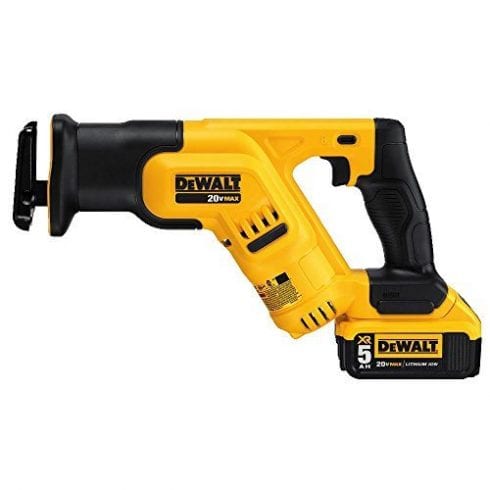
Only 14.5-inches in total length, this seven-pound Dewalt reciprocating saw is compact and lightweight, which makes it easy to cut into those hard-to-reach areas. In addition, the four-position blade clamp gives better versatility and allows for flush-cutting in difficult angles with tool-free blade changes.
Surprisingly powerful for its size, this saw has a variable speed trigger that drives up to 2900 strokes per minute. It also features an impressive stroke length of 1-1/8-inch, delivering faster blade speed. There is a pivoting shoe that also provides more control and versatility.
With an impressive 4.7 out of five-star rating, this reciprocating saw is a huge hit with consumers for its overall versatility, durability, and performance. We like the fact that it's so lightweight and compact. It's very easy to maneuver and transport to different areas. The LED light is a convenient feature, especially in darker, tighter areas with insufficient lighting to see the job. This provides a more confident and safer cutting experience, making it one of the best cordless reciprocating saws for nighttime use.
Check Price on Amazon ➞3. BLACK+DECKER BDCR20B 20V
Best Cordless Reciprocating Saw for Vibration Control and Ease of Use

Lightweight and powerful, this cordless reciprocating saw delivers a tool-free blade changing system for more convenience. It also features a a variable speed trigger and a pivoting shoe for more control.
This cordless reciprocating saw gets the job done faster and more efficiently, made to deliver up to 30-percent more output. The 7/8-inch blade delivers more cutting precision and control and less kickback than longer blades. Black & Decker goes the extra mile by providing dampening technology for low vibration. This cordless reciprocating saw includes one blade, and the battery is sold separately.
This is a cordless reciprocating saw that is still very powerful and built to last. It will deliver up to 3,000 strokes per minute. Having new dampening technology ensures a nice, smooth cutting experience with less vibration. The lightweight handling makes this cordless reciprocating saw easy for anyone to handle.
Check Price on Amazon ➞4. SKIL 9216-01 9 Amp
Best Corded Reciprocating Saw with a Toolless Blade Change
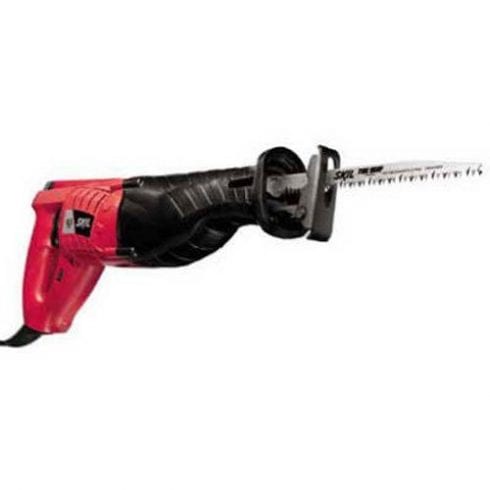
With a reliable, durable nine-amp motor that powers through just about any type of material without a glitch, this corded reciprocating saw makes cutting an enjoyable experience and guarantees a great performance.
Depending on the toughness of the project, users can manipulate and manage the speed rate of the saw, providing a more controlled, safer cutting experience. Speaking of safety, this saw includes a tool less blade change for hassle-free changing and a counterbalance and pivotal foot for extra sturdiness during work.
As for comfort, the soft-grip handle makes it easy to handle this corded reciprocating saw while reducing fatigue. The manual provided with this reciprocating saw is easy to understand. You'll soon know which type of blade works best with which project — making this saw ideal for novices and experts alike.
The overall performance of this compact reciprocating saw is what impressed us. The high-powered motor doesn’t discriminate. When we tested it, this corded saw cut through concrete and wood. Not only powerful but easy to handle, this saw makes a great addition to anyone’s workshop.
Check Price on Amazon ➞5. DEWALT DWE304 10-Amp
One of the Best Reciprocating Saws for Both Wood and Steel
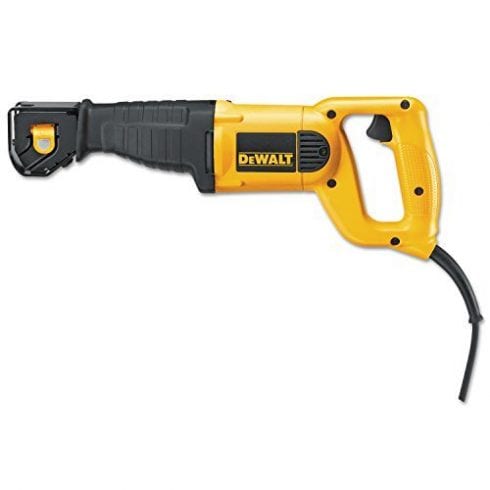
Corded reciprocating saws always pack a punch, and this Dewalt reciprocating saw is no exception. This powerful saw features a 10 amp motor designed for performance in heavy-duty applications. There is a four-position blade clamp allowing for better versatility in limited clearance. It makes it possible to flush-cut from nearly any angle. There is also a fixed shoe for extra sturdiness during work, along with a keyless lever-action blade clamp for easy blade changing. With up to 2800 strokes per minute, it also has a variable speed trigger for better user control.
Typical materials for these reciprocating saws to tackle are wood, light to heavy gauge metals, drawl, plaster, plastic, rubber, fiberglass, and composite material. This DeWalt tool comes backed by a three-year limited warranty.
DeWalt has made cutting fun again with this saw's powerful and versatile features. Changing blades is easy-breezy. Just lift a small lever, and this instantly disengages the blade. The quality is excellent. This Dewalt reciprocating saw doesn't seem to notice the difference between light wood and steel - it cuts through both materials just like butter.
Check Price on Amazon ➞6. Bosch RS428 14 Amp Reciprocating Saw
One of the Best Reciprocating Saws for Vibration Control

If the 14-amp motor doesn’t impress you enough when it comes to this reciprocating saw, combine that with the compact and lightweight design and a best-in-class power to weight ratio. All of that will surely get your attention! Even the most cantankerous reciprocating saw masters will enjoy all the power, precision, and durability this saw produces.
A 10-piece blade set is included with this reciprocating saw. Bosch has made this saw with precision-ground teeth and thick blades designed for general-purpose cutting. It provides endurable performance in wood, wood with nails, and metals. There is tool-less blade change for quick, easy removal, and the soft, ergonomic handle improves comfort and reduces fatigue.
Bosch has thought of it all when it comes to providing the most powerful, durable, and comfortable sawing experience. We love how this reciprocating saw’s dual LED lighting system illuminates the cutting zone for an overall safer experience. The blades work great, are easy to change out, and overall this reciprocating saw performed impressively, and with it being a corded model there were no more worries on how long the battery was going to last.
Check Price on Amazon ➞7. PORTER CABLE PCC670B 20v
Best Cordless Reciprocating Saw for Professionals and Hobbyists Alike
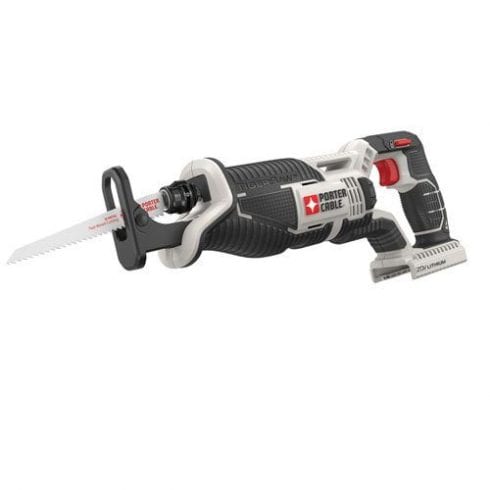
Porter-Cable is a trusted brand and is known for its high-performance power saws. This cordless reciprocating saw stands up to its reputation well with its overall versatility.
Lightweight and compact, this cordless reciprocating saw is ideal for more challenging work in confined areas. With a high-performance motor and one-inch stroke length, this is designed for general contractors, do-it-yourselfers, or remodelers alike. It's easy for anyone of any experience level to use. There's a tool-less blade system and pivoting shoe to hold the blade securely and precisely. The variable speed trigger offers more control.
This compact, cordless saw makes the whole cutting experience so much easier. It fits into just about any tight spot, sawing with a lot of power and precision. The ergonomic handle makes it nice and comfortable to grip. At just under four pounds, this makes this the best cordless reciprocating saw for just about anyone to use effectively.
Check Price on Amazon ➞8. Milwaukee 6519-31 12 Amp Sawzall
One of the Best Reciprocating Saws for High Performance

This reciprocating saw delivers the best-in-class cut speed, durability, and power with a 0-3000 strokes per minute, a 1-1/8-inch stroke length, and a 12 amp motor. The gear-protecting clutch extends the gear and motor life with its high-impact absorption. The QUICK-LOK brake clamp provides fast tool-less blade changes. The redesigned front grip of this reciprocating saw gives excellent ergonomics and comfort.
Packed with plenty of power and comfortable ergonomics, Milwaukee is a name you can trust in the line of reciprocating saws. This reciprocating saw is used by professionals and DIY-ers all over for its reliability, durability, and power.
Check Price on Amazon ➞9. Makita JR3050T 11 Amp
One of the Best Reciprocating Saws for Safety
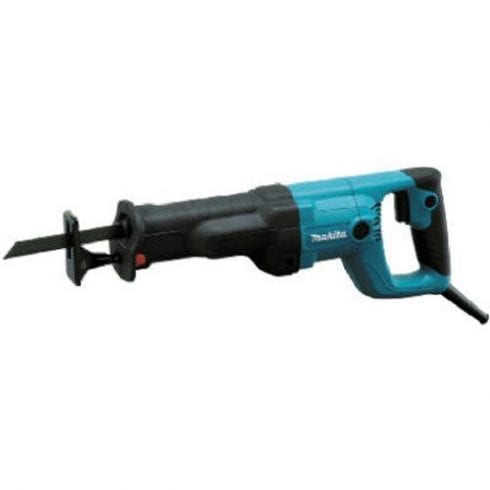
This saw combines a powerful 11-amp motor with a 7.3-pound weight, giving it better performance and handling. The variable speed goes up to 2800 SPM, and it features a one 1/8-inch blade stroke for effective, efficient cutting. It'll cut metal, wood, drywall, plastics and take care of remodeling and demolition work. There is also an internal dust blower system that conveniently clears away debris for improved visibility and more precise cuts. The tool-less blade change with a heavy-duty shoe provides fast-changing convenience.
These Makita saws are securely constructed to keep debris out and ensure a longer saw life. They feature ball and needle bearings and a protective rubber boot that seals the motor and bearings from outside elements.
For just about any application, this power tool does the job well. Makita goes the extra mile by not only giving this saw an 11-amp motor but providing many convenient and safe features, extending the longevity with its overall design. Easy to handle, this reciprocating saw does a professional-level job at an ordinary-level cost. For its durability, it cannot be beaten.
Check Price on Amazon ➞10. Metabo HPT Reciprocating Saw
One of the Best Reciprocating Saws for Precise Cutting
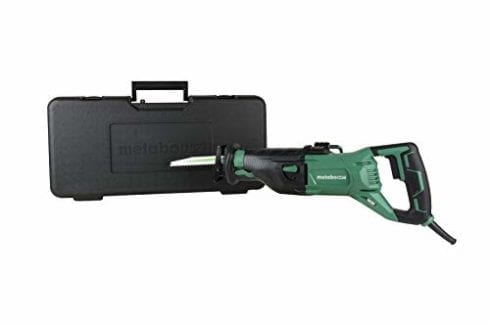
As a leader in power tool technology, Metabo impresses us once again with its groundbreaking User Vibration Protection. The motor delivers 2800 strokes per minute. You can control the variable speed by dial or trigger for precise cutting in a wide variety of applications and materials.
Check Price on Amazon ➞Buyers Guide Questions
What Is a Reciprocating Saw Used For?
When used properly, reciprocating saws can be a lot of fun to handle and might just turn you into a demolition junkie. For instance, a tear-down project that would normally take a lot of hours of struggle to rip down and break apart will become so much easier with a reciprocating saw. The best reciprocating saws will cut through all the materials in a quarter of the time. Windows, walls, plumbing, doors, etc. – just cut away and toss. You’ll wonder where this magical little tool has been all your life.
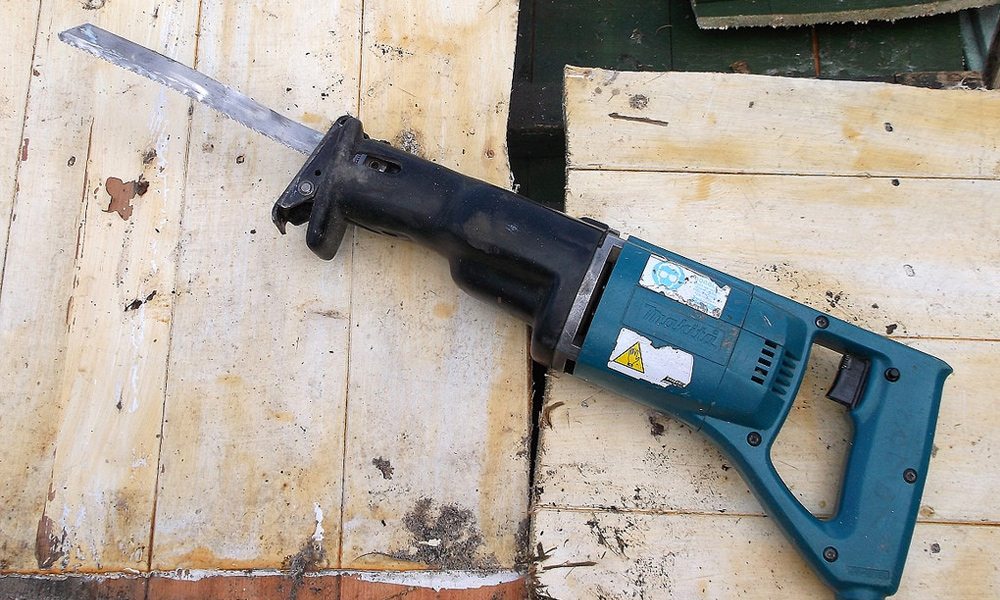
Also referred to as a “gateway tool,” the reciprocating saw is what you’ll own when you finally graduate to a Serious DIY’er. This is the tool that sets you apart from novice wannabes. A reciprocating saw is not for fine crafting. Instead, it’s used for breaking down and tackling bigger projects.
The best reciprocating saws are designed for getting into those tight spaces. They feature an exposed blade and different positioning for precision angle cutting. Several types of blades are used with a reciprocating saw, depending on the project and material being cut. For instance, a fine-tooth blade that resembles a hacksaw is used for cutting through metal pipe and nails; a coarse blade is for cutting wood; a super-coarse blade for plaster; and a “toothless” blade for cutting stone. These are specially coated with a tungsten carbide abrasive grit.
However, you don’t have to be uber-picky when choosing the best blade either. For example, you can use a nail-cutting blade to slash through roof shingles and plywood. The more you familiarize yourself with what your saw can do, the more confident you’ll be when choosing a blade for a specific job. Most types of blades are a standard six-inch in length, but smaller ones like jig-saw types are available.
There are also 12-inch blades that are useful for getting into deep crevices or cutting through thick timber. Although blades are tough, they are not indestructible. They are disposable and should be replaced when you notice a dull blade. There are also bimetal blades that are bonded with steel teeth. These will remain flexible longer and outperform the standard carbon steel blades with faster cutting, but they cost more.
Blades can be hammered flat and reused if bent. You can also try a little trick by cutting the tip off at an angle with some tin snips, presenting a sharper blade. Just be sure to wear safety goggles for this!
Features
Both corded and cordless reciprocating saws come with different features and the best saw for you will depend on your needs. Do you need your power tools to get into tight spaces? Are you looking for a powerful motor to tackle heavy-duty work? Do you need a corded or a cordless option?
Let’s start with the latter. The best cordless reciprocating saw is lightweight and portable to fit into tight spaces. This compact tool is best for people who work on location rather than in a shop as the best cordless reciprocating saws give you the freedom that corded models don’t. Many have just as much power as their corded counterparts.
Corded models are certainly powerful power tools. You might need an extension cord to power them, but it’s worth it. Other features you should look out for include low vibration, electronic cell protection, a brushless motor, and more.
How to Extend the Life of your Blades:
There are also several techniques you can apply to extend the life of your blades further.
- Be sure to apply the right pressure to your reciprocating saw. Don’t worry – you’ll learn this through experience. This is an intricate balance between knowing when to bear down and when to go light.
- Make sure your reciprocating saw’s shoe is tight on the material’s surface. This reduces vibration and will increase the cutting speed.
- Applying a rocking up and down motion with your saw will definitely increase the cutting speed.
- If you need to get close to cut nails beneath lapped siding, flip over the blade, so the teeth are up in the clamp assembly, then cut away, making sure you don’t cut into the siding.
Although reciprocating saws are made to be relatively safe during use, these are still dangerous saws. You still need to follow common safety rules. (Click to view the study on this).
- Stay aware of where electrical wiring, heating vents, and plumbing pipes are in your area before cutting.
- When changing out blades, always unplug the saw first.
- Stay aware of “kickback” – when the blade’s tip comes into contact with the material and bucks violently. This could throw you off balance. Be especially aware of this when perched on a telescoping ladder. This could also happen when cutting through pipes or wood.
- Blades will generate heat when cutting. Avoid touching the blade right after you’ve been sawing. Let it cool before changing the blade.
Are Reciprocating Saw Blades Universal?
The short answer is yes. Reciprocating saw blades fit into any standard reciprocating saw on the market. The length of these saw blades ranges from three to 12 inches, dictating how deep the cut will be. The width and thickness determine how stable the blade is. Each saw blade for a reciprocating saw is designed for a specific task and vary in dimension, material, number of teeth, bevel, thickness, and angle. Let’s break this down:
- Carbon steel blades are the most common and inexpensive blade. They’re suited for cutting softwoods but will dull quickly with hardwoods and other hard materials.
- High-speed steel (HSS) blades are more expensive than carbon steel, but also much harder, allowing them to cut through hardwoods without dulling as quick. They make a great choice as an all-purpose, long-lasting blade. They last five times longer than carbon steel blades.
- Bi-metal blades are harder and last on average up to ten times longer than a carbon steel blade.
- Carbide-tipped blades are the most common type of bi-metal saw blades and work best for particularly tough cuts.
- Carbide-grit blades are more abrasive and made of harder materials like brick, marble, ceramic, and fiberglass. As the most common type of abrasive reciprocating blade, the coatings range from medium to heavy-duty.
- Diamond blades have real diamonds embedded in the tips. You can use them to cut through glass, ceramic, and concrete. There are six types of blades that are made to do specific tasks:
- A ripping blade has a larger gullet (the area between teeth) and few teeth which remove wood quickly and efficiently, producing a rough cut
- A crosscutting blade has many teeth and a small gullet that produces a very smooth and concise cut.
- A combination blade is more of a general-purpose blade. It’s between ripping and crosscutting – perfect for a wider range of tasks.
- Plywood blades have more teeth than crosscutting, which helps to suppress the chipping and splintering common to plywood, creating a smoother, cleaner cut.
- Thin kerf blades are for easier cutting without much waste. The kerf is the size of the slot the blade cuts in the material.
- An abrasive blade is coated with a coarse material, allowing them to cut through tile, masonry, and steel. Each type of blade has distinct features that allow it to do its best with specific tasks:
- A variable pitch blade has a different TPI (teeth per inch) at various points. For example, it could have a pitch rating of 10/14, which means that it varies from 10 to 14 TPI. This variable pitch reduces vibration and provides a faster cut, allowing for use on a wider variety of materials.
- A tapered blade is for plunge cuts where the reciprocating saw starts cutting directly on the surface rather than on the edge of material – so it is tapered to allow it to plunge right in.
- Specialty blades are designed for specific materials and are convenient for non-professionals. They can choose the best blade without a lot of knowledge.
- Bi-directional blades have teeth that will cut in both directions, allowing the blade to cut in both pushes and pull motions, resulting in faster cuts. This isn’t suitable for all jobs but works best for materials such as plaster, for instance.
Can I Use a Reciprocating Saw To Cut Through Tree Limbs?
A reciprocating saw is comparable to a jigsaw (click to read and view for our full guide). It’s designed for quick cutting jobs that don’t have to be pretty but just have to be done fast and right. Besides being a demolition saw, a reciprocating saw is also great as a tight-restricted area saw, a pipe cutter, a drywall saw, and a conduit cutter.
Many saws can be used for pruning trees, but if you are tasked with cutting several limbs or thicker branches, you’ll want a tool that is equipped specifically for this job – like a reciprocating saw.
The general advantages of using a reciprocating saw instead of other types of saws revolve around their overall flexibility. The best reciprocating saws are much more lightweight and safer to use than a circular saw for work. Those types require being perched on a ladder. They can work in tight, confined areas or behind fixed materials, where other reciprocating saws cannot fit. They do an excellent job at cutting holes or slots in the middle of drywall or sheets, and they will make flush cuts around adjacent materials like a breeze.
So, back to cutting through tree limbs — The answer to this question is yes. The reciprocating saw is one of the best saws for pruning tree limbs or cutting small trees. You can actually use a standard reciprocating saw blade to cut tree branches, but a reciprocating saw will only work as well as the blade that’s intended for a specific project – like a pruning blade. Most people don’t realize that there are pruning blades specifically for these reciprocating saws!
Many different reciprocating saws will perform well for your needs, such as the DEWALT Bare-Tool DC385B Cordless reciprocating saw or the BLACK+DECKER BDCR20B 20V reciprocating saw. A good example of the correct blade to use would be a 12 inch 4/5 TPI pruning blade, made to provide a cleaner, faster cut through wood, with a thin kerf for more flexibility.
All you have to do is put on your safety glasses, insert the pruning blade into your reciprocating saw (or saws-all), turn it on, and saw it off. That’s it! The job is done in seconds.
Can a Reciprocating Saw Cut Trees?
When deciding on the best reciprocating saw for cutting down trees, there are a lot of variables to consider: One – what kind of tree (or trees) you want to fell, and two – how experienced you are with reciprocating saws. Using a chainsaw is probably the best solution to felling large trees, especially hardwoods because that is what they are made to do. Make sure you have the right chainsaw chain here.
However, don’t attempt to operate a chainsaw on a huge tree unless you’re pretty darn experienced— they are about the most dangerous power tool there is and can maim or even kill you in seconds. So if you don’t know what you’re doing, you’re much better off finding someone who does.
That said, maybe they aren’t huge trees, but soft pines or smaller trees you want to clear. Now your job just became a lot safer and easier to handle. A reciprocating saw, used with the right blade for the task, can provide a safer and more successful way to fell smaller trees with a little patience and know-how.
Much lighter and smaller than a chainsaw, a reciprocating saw also makes sawing off those higher branches easier. Make sure you use a blade that’s made to cut through wood. A good example would be a 12 inch 4/5 TPI pruning blade, made to provide a cleaner, faster cut, with a thin kerf for the best flexibility.
How To Use a Reciprocating Saw
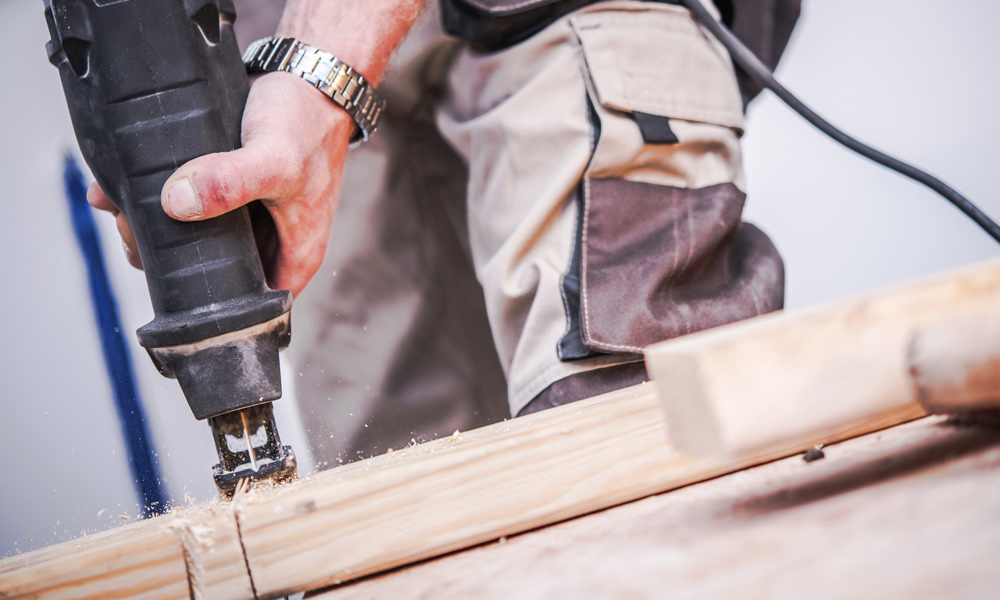 Known as the “swiss army knife” of saws, the reciprocating saw is designed to do a wide variety of cutting tasks around the home and on the construction site. If you currently don’t know how to operate a reciprocating saw, you should. When you do, it’ll probably be all you ever need (view the study and instructions on use here). A reciprocating saw, or recip saw as many call it, wears many hats: It’s a demolition saw, a fine-finishing saw, a tight-restricted area saw, a pipe cutter, a drywall saw, and a conduit cutter. It’s even a great tree pruner and a small tree cutter. Click here to view the full study.
Known as the “swiss army knife” of saws, the reciprocating saw is designed to do a wide variety of cutting tasks around the home and on the construction site. If you currently don’t know how to operate a reciprocating saw, you should. When you do, it’ll probably be all you ever need (view the study and instructions on use here). A reciprocating saw, or recip saw as many call it, wears many hats: It’s a demolition saw, a fine-finishing saw, a tight-restricted area saw, a pipe cutter, a drywall saw, and a conduit cutter. It’s even a great tree pruner and a small tree cutter. Click here to view the full study.
The fact is, once you’ve learned the secrets of what this reciprocating saw will do, you’ll want to have one. Now. Then it just becomes a matter of deciding which brand of reciprocating saw and which blades you need to do your tasks at hand. From there, it includes choosing from a variety of sizes and models, whether you want corded or cordless, stroke, and tool weight. And then there are other considerations to weigh in.
For example, does the blade reverse to cut up or down? Does the handle stick out? How comfortable is the grip? How big is the saw, or how lightweight is it? Modern technology from reciprocating saw manufacturers has fine-tuned this tool over time, with huge advancements, especially in the last decade. Faster cuts, more power, variable speed, more compact size, lighter weight, better casing, even reciprocating saws that can be handled with one hand. This is all at an affordable cost, making this powerful little tool even more valuable.
For corded reciprocating saws, having a higher amp will suffice for most jobs, and anything over 12 amps will do the work well. However, if you prefer to have a cordless (or battery-powered) reciprocating saw, today’s models will impress you with their powerful, long-lasting lithium batteries. Many deliver as much as 50 percent more work output and 50 percent more charges to the life of the battery. These cordless reciprocating saws are also better equipped to handle extreme heat and cold temperatures.
Another factor to consider is the stroke length or the distance the blade travels in one forward stroke. This can vary according to the size of the recip saw. A long stroke reciprocating saw will cut faster but need more clearance to do its job and more amps to drive the blade. As a rule of thumb, use a long-stroke model for demolition work and a shorter stroke saw for more delicate, precise work.
An orbital reciprocating saw adds oscillation, or back and forth movement, to regular reciprocation. It adds a slight up and down motion, resulting in an oval-like cut that is best for wood. A short-stroke reciprocating saw allows you to get into tighter places where other saws cannot reach. A heavier reciprocating saw will reduce vibration a little more than lightweight saws. However, you may prefer a lighter weight. The best reciprocating saws for you depend on your own personal preference.
Tip: When shopping for a reciprocating saw, lift the model above your head to see how comfortable it feels. If vibration is an issue for you, look at models with AVT – anti-vibration technology. Makita, for example, is known for its AVT models. Now that you have a little background in reciprocating saws, and know what you want, let’s learn how to handle it.
How to Use a Reciprocating Saw
Choose the Right Blade
If you don’t have the correct blades, reciprocating saws instantly become the wrong tool. Choosing the correct blade for the specific project ensures the best experience. Of course, there are many different blades for a reciprocating saw, but doing your homework before you choose will make all the difference. If you’re unsure which blade to choose for the project, we recommend starting with a material-specific blade.
For instance, if you’re working with steel, choose a blade specifically for working on steel projects. Of course, there will still be a lot of choices, but this category will narrow them down.
Insert the Blade into the Chuck
Make sure the tool is unplugged first, or remove the battery in cordless reciprocating saws, then insert the blade. Just about all of today’s reciprocating saws on the market have a tool-free chuck system that works by simply quarter-turning or half-turning to release and insert the blade. Allowing the chuck to return to its original position secures the blade in place. It’s always best to give the blade a little tug to ensure it’s secured in the chuck before operating. When removing a blade, use gloves to remove it because it will be hot.
Know How Your Cut Will Go Before You Begin
Once that reciprocating saw comes into contact with your material, your focus will be on how it is cutting. But the blade will extend far beyond the cut. Make sure your blade won’t hit anything else in its path. This is especially important to consider when you are plunge-cutting into drywall where you cannot see what’s on the other side of the drywall. It’s important to check for electrical wiring, plumbing, etc., before you begin.
Know your Speed
Once you get a feel for the speed of your reciprocating saw, this will become more intuitive. Before cutting, create a small cut to see how it reacts to the material in speed and torque. This will help you gain more control over the bulk of the work. As the blade approaches the exit of the cut, you’ll want to slow down.
The Shoe is Good to Have
The shoe is more like the nose of the reciprocating saw. Its flat surface acts as the base and serves several purposes for this saw. You can adjust some shoes to move forward or back to extend the blade life, but even a shoe that remains stationary is important. The shoe also works to stabilize the saw and the material. If you push the shoe all the way against the material you are cutting, you’ll find that the vibration of the saw will reduce dramatically.
If you’re cutting the material too shallow, you’ll see an increase in the vibration of the saw or the material itself. Also, the shoe acts as a fulcrum for plunge cuts. Raising the back end of the saw and allowing the shoe to work as a pivotal point gives you more control to plunge into the material.
Slowly Work the Blade as a See-Saw in a Thicker Material
If the blade progresses slowly through the heavy or thick material and gives you quite the workout, it can mean a couple of things. One – that the blade is dull and needs to be replaced. Or two, it could just mean that you’re not letting the reciprocating saw do all the heavy lifting.
When working with the denser material, you will need to rock the blade back and forth like a see-saw. Then you will find that the saw makes faster progress. This reduces the load and allows the blade’s teeth to focus on a smaller section at a time.
What Types of Reciprocating Saws Blades Are There?
Depending on the type of project and the material being cut, several types of blades can be used with a reciprocating saw. For example, a fine-tooth blade resembles a hacksaw. It can be used for cutting through metal pipes and nails. Use a coarse blade for cutting wood, a super-coarse blade for plaster, and a “toothless” blade for cutting stone. These are coated with a special abrasive grit.
The longer you work with your reciprocating saw, the more familiar you will become with how it works and what you can accomplish with it. Then, you’ll have more confidence in choosing a blade for a specific task. Depending on how a particular blade functions, you can actually use one type of blade for several different projects. For example, you can certainly use a nail-cutting blade to work with shingles or plywood.
Most reciprocating saw blade sizes range from three to 12 inches in length, but the standard size is six inches. Jig-saw types are available as well.
12-inch blades are useful for getting into deeper crevices or cutting through thicker timber. Although they’re tough, these blades are not indestructible. Rather, they are disposable, and you should replace them when you notice that they are getting dull and slowing down the job.
The number of teeth per inch (TPI), combined with the gullet size and the kerf, all determine the material the blade can cut.
- Blades with a low TPI deliver faster cuts and rougher edges, ideal for wood.
- Blades with a high TPI deliver smooth, slow cuts, ideal for metal – read through our guide for the perfect metal cutting tool.
- The number of TPI ranges from 3 to 24.
- To reduce snagging, try to have at least three teeth come into contact with the material at all times.
Length, Width, and Thickness
There are three facets to a reciprocating saw blade to keep in mind: length, width, and thickness.
- The longer the blade, the deeper the cut.
- Wider blades will reduce bending and wobbling.
- Heavy-duty blades are typically 7/8-inches wide and 0.062-inches thick.
- Blades that are 0.035-inches thick provide sufficient strength for standard cutting.
- Blades that are 0.05-inches thick are for enhanced stability.
- For plunge-cutting jobs, short blades with tapered backs do the best work.
To extend the life of your blades, you can try hammering out the blade flat if it’s bent. You can also try cutting off the tip at an angle with some tin snips. This presents a sharper blade. Make sure you wear safety goggles for this.
Let’s look at the different types of reciprocating saw blades currently on the market:
- Carbon steel. As the most common blade, this is great for cutting softwood and plastic but will dull quickly with hardwoods and other hard materials. These are flexible to allow for bending without breaking.
- Bimetal blades are bonded with tool steel teeth and will remain flexible longer, outperforming the standard carbon steel blades with faster cutting, but they are more expensive. Carbide-tipped blades are the most common bimetal reciprocating saw blade, working very well for the tougher cuts.
- High-speed steel (HSS) blades are also more expensive than carbon steel, but they are also much harder. This allows them to cut through hardwoods without dulling as quickly. It makes the best choice as an all-purpose, long-lasting blade, lasting five times longer than carbon steel. These blades have durable teeth but are more prone to breakage.
- Carbide-grit blades are a more abrasive blade made for harder materials like marble, ceramic, cement board, and fiberglass. This is the most common type of abrasive reciprocating blade. It has a coating that ranges from medium to heavy-duty.
- Diamond blades have real diamonds embedded in the tips and cut through glass, ceramic, and concrete. Six types of blades are made to do specific tasks:
- A ripping blade has a larger gullet (the area between teeth) and few teeth, which remove wood quickly and efficiently, producing a rough cut.
- A crosscutting blade has many teeth and a small gullet that produces a very smooth and concise cut.
- A combination blade is more of a general-purpose. It’s between ripping and crosscutting, for a wider range of tasks.
- Plywood blades have more teeth than crosscutting, which helps to suppress the chipping and splintering common to plywood, creating a smoother, cleaner cut.
- Thin kerf blades are for easier cutting without much waste. The kerf is the size of the slot the blade cuts in the material.
- An abrasive blade is coated with a coarse material, allowing them to cut through tile, masonry, and steel.